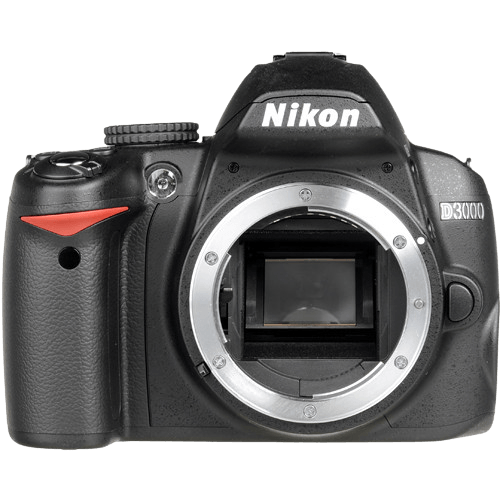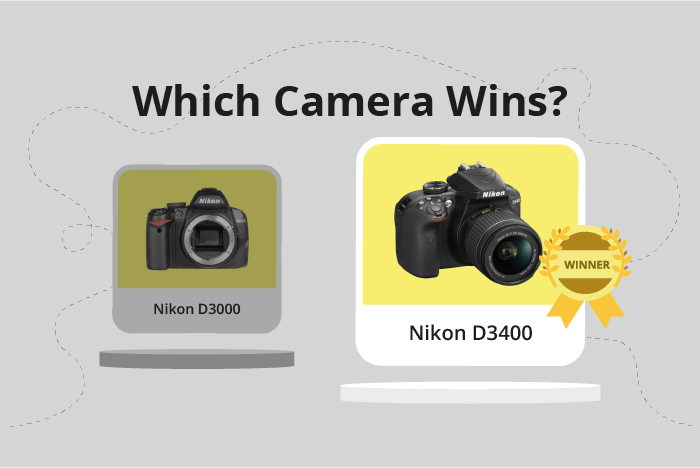Nikon D3000 vs D3400 Comparison
Nikon D3000

Nikon D3400

The Nikon D3400 outperforms the Nikon D3000 with a score of 61/100 compared to 36/100. Both cameras share similarities as DSLR cameras, announced in 2016 and 2009, respectively. The D3400 has the advantage of being lighter, weighing 445g, while the D3000 weighs 536g. Additionally, the D3400 has a lower launch price of $650, compared to the D3000’s $730.
The D3000, however, is slightly smaller in size (126 x 97 x 64mm) than the D3400 (124 x 98 x 76mm). Despite this minor advantage, the Nikon D3400 is the clear winner due to its better score, lighter weight, and lower price.
Nikon D3000 vs D3400 Overview and Optics
The Nikon D3400 emerges as the winner in the optics comparison with a score of 65/100, outperforming the Nikon D3000, which received a score of 43/100. Both cameras share some common specifications, including an APS-C sensor size, a Nikon F DX lens mount, and a lack of image stabilization.
The D3400 surpasses the D3000 in several key aspects. With 24.2 megapixels, it offers a significant advantage in image resolution compared to the D3000’s 12.3 megapixels. This allows for greater detail and larger prints. The D3400 also boasts a faster shooting speed of 5 frames per second, compared to the D3000’s 3 frames per second, providing better performance in capturing fast-moving subjects. Additionally, the D3400 features a more advanced CMOS sensor and Expeed 4 processor, resulting in a higher DXOMARK score of 86, as opposed to the D3000’s CCD sensor and Expeed processor, which received a score of 62.
In contrast, the D3000 does not hold any significant advantages over the D3400 in terms of optics. The lower megapixel count, slower shooting speed, and older sensor and processor technology place it at a disadvantage compared to its counterpart.
Taking these points into consideration, the Nikon D3400 clearly outperforms the Nikon D3000 in the optics department. The higher megapixel count, faster shooting speed, and more advanced sensor and processor contribute to its superior performance. While both cameras share some common features, the D3400’s advantages make it the better option for photographers seeking enhanced image quality and performance.
Nikon D3000 vs D3400 Video Performance
When comparing the video capabilities of the Nikon D3000 and the Nikon D3400, it is essential to note that the Nikon D3000 does not have video functionality. This absence of video recording capabilities in the D3000 makes it unsuitable for those looking to capture video footage.
On the other hand, the Nikon D3400 has video capabilities with a score of 56/100. The camera offers Full HD video resolution, with maximum video dimensions of 1920 x 1080. Additionally, the D3400 can record video at a maximum frame rate of 60fps, providing smooth and clear footage. However, the camera does not have built-in time-lapse functionality.
Taking the video capabilities into account, the Nikon D3400 clearly surpasses the Nikon D3000 for users interested in capturing video. The D3400’s Full HD resolution, 60fps frame rate, and overall video score make it a more suitable option for videographers, while the D3000 remains a photography-focused camera without video functionality.
Nikon D3000 vs D3400 Features and Benefits
The Nikon D3400 emerges as the winner in the features comparison, scoring 54 out of 100 points, while the Nikon D3000 lags behind with a score of 23 points. Both cameras share some common specifications, such as a 3-inch screen size, lack of touchscreen, flip screen, GPS, and WIFI capabilities. However, the D3400 excels in certain aspects, making it a better choice for many photographers.
The D3400 boasts a screen resolution of 921,000 dots, providing a clearer and more detailed display than the D3000’s 230,000 dots. This higher resolution allows photographers to better review their images and make necessary adjustments on the go. Additionally, the D3400 is equipped with Bluetooth connectivity, allowing for seamless image transfer to compatible devices. This feature is absent in the D3000, making the D3400 more convenient for those who wish to share their images quickly and effortlessly.
Despite its lower feature score, the D3000 may still be a viable option for those who prioritize simplicity and do not require advanced image-sharing capabilities. However, its lower screen resolution may be a significant drawback for users who need to review their images in detail.
Taking these factors into account, the Nikon D3400 stands out as a superior choice in terms of features, offering a higher screen resolution and Bluetooth connectivity. Meanwhile, the Nikon D3000 may cater to those who prefer a more basic camera without advanced image-sharing options. Ultimately, the choice between these two cameras depends on the individual’s specific needs and preferences.
Nikon D3000 vs D3400 Storage and Battery
The Nikon D3400 outperforms the Nikon D3000 in storage and battery with a score of 45 out of 100, while the D3000 scores 27. Both cameras have one memory card slot and neither offers USB charging. They differ in memory cards accepted and battery life.
The D3400 accepts SD, SDHC, and SDXC memory cards, providing more storage options than the D3000, which only accepts SD and SDHC cards. Furthermore, the D3400 has a significantly longer battery life, boasting 1200 shots per charge compared to the D3000’s 500 shots. The D3400 uses the EN-EL14a battery type, while the D3000 uses the EN-EL9a.
The D3000 does not surpass the D3400 in any storage or battery aspects. The D3400’s advantages in memory card compatibility and battery life make it the clear winner in this comparison.
Nikon D3000 vs D3400 – Our Verdict
Are you still undecided about which camera is right for you? Have a look at these popular comparisons that feature the Nikon D3000 or the Nikon D3400:

